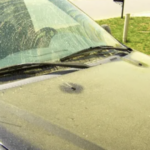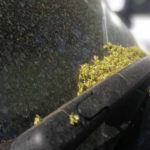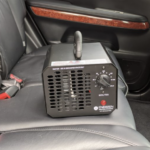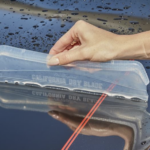How Professional Detailing Can Remove Scratches & Swirl Marks from Your Paint
Why Scratches and Swirl Marks Ruin Your Car’s Appearance
Scratches and swirl marks are some of the most common issues affecting a car’s paint. Over time, improper washing, environmental contaminants, and general wear cause fine scratches that dull the surface. Even new cars can develop swirl marks due to factory washing techniques or careless handling at dealerships.
Unlike deep scratches, which penetrate the clear coat, most swirl marks and light scratches sit on the surface. While they don’t necessarily damage the integrity of the paint, they diminish the car’s overall shine, making the surface appear dull and worn.
For car owners who take pride in their vehicle’s appearance, addressing these imperfections is essential. Proper detailing removes scratches, restores depth, and enhances the paint’s clarity.
What Causes Scratches and Swirl Marks?
1. Improper Washing Techniques
One of the biggest causes of scratches and swirl marks is improper washing. Using dirty sponges, rough towels, or automatic car washes with abrasive brushes grinds dirt into the paint, creating fine scratches.
Dry wiping a dusty car is another common mistake. Dust and dirt act like sandpaper when rubbed against the surface, leading to visible swirl marks.
2. Contaminants and Road Debris
Even careful drivers can’t avoid road debris, tree sap, bird droppings, and industrial fallout. These contaminants harden on the paint, and if removed incorrectly, they leave behind micro-abrasions.
3. UV Damage and Oxidation
Over time, exposure to the sun’s UV rays weakens the paint’s clear coat. As oxidation occurs, the surface becomes more prone to scratches and swirl marks. Vehicles left parked outdoors for extended periods develop faded, rough patches that collect more contaminants.
4. Poor Drying Techniques
Using old bath towels or paper towels to dry a vehicle creates unnecessary friction, leading to surface scratches. Quality microfiber towels and air drying techniques help prevent these issues.
How Professional Auto Detailing Removes Scratches and Swirl Marks
Auto detailing involves multiple stages of correction, including paint decontamination, polishing, and sealing. Professional detailers use advanced techniques to restore paint without causing further damage.
Step 1: Paint Decontamination and Clay Bar Treatment
Before correcting scratches, detailers remove embedded contaminants using a clay bar treatment. This process smooths out rough surfaces and removes particles that traditional washing cannot eliminate. A decontaminated surface allows polishing compounds to work more effectively.
Step 2: Paint Correction Using Machine Polishing
Paint correction is the process of removing defects in the clear coat through polishing. Detailers use dual-action polishers and cutting compounds to level out the surface.
- Light scratches and swirl marks require a fine polish with a soft foam pad.
- Moderate scratches need a more abrasive compound to remove imperfections.
- Deep scratches that have not reached the base coat require multiple polishing stages.
By refining the paint’s surface, professional detailers restore the car’s deep, reflective shine.
Step 3: Applying a Paint Sealant or Ceramic Coating
After polishing, applying a sealant or ceramic coating protects the newly corrected surface. These coatings create a hydrophobic layer that reduces future swirl marks by repelling dirt and water.
Why DIY Scratch Removal Methods Often Fail
Many car owners try to fix scratches themselves using over-the-counter scratch removers or hand polishing techniques. While some minor defects can be improved with DIY solutions, they often fail to fully restore the surface.
Common DIY Mistakes:
- Using the wrong polishing compound – Too aggressive, and it removes too much clear coat; too mild, and it fails to correct deeper marks.
- Not preparing the surface – Scratches remain visible if contaminants are not removed before polishing.
- Applying too much pressure – Hand polishing without proper technique can cause uneven results.
- Skipping the protection step – Without wax, sealant, or ceramic coating, new scratches form more easily.
Professional detailing provides consistent, high-quality results by using industry-grade tools and materials.
When to Choose Professional Paint Correction
If scratches and swirl marks cover large portions of your car’s surface, professional paint correction is the best solution. A full paint correction service eliminates most visible defects and restores the factory shine.
Paint correction is ideal for:
- Vehicles with dull or hazy paint that no longer reflects light.
- Cars with noticeable swirl marks from improper washing.
- Older vehicles needing restoration after years of oxidation and fading.
- Owners preparing their car for resale who want a showroom-quality finish.
Although paint correction does not fix deep scratches that penetrate the base coat, it significantly improves the overall appearance of the vehicle.
How to Prevent Future Scratches and Swirl Marks
After removing imperfections, adopting better maintenance habits helps preserve the paint’s condition.
Best Practices for Scratch Prevention:
- Use the Two-Bucket Wash Method
Separating wash water from rinse water reduces the risk of rubbing dirt back onto the paint. - Wash with High-Quality Microfiber Mitts
Soft microfiber prevents scratches better than standard sponges or rags. - Avoid Automatic Car Washes with Brushes
Touchless washes or hand-washing methods reduce the chance of paint damage. - Apply a Ceramic Coating or Paint Sealant
A protective layer makes it harder for contaminants to bond to the surface. - Use a Dedicated Drying Towel or Air Blower
Letting a car air dry increases water spotting, while rough towels cause surface abrasions.
By following these techniques, car owners maintain a swirl-free, glossy finish for much longer.
The Cost of Paint Correction vs. Repainting
Many drivers assume that a full repaint is the only way to fix a scratched surface. However, paint correction is often a more cost-effective solution.
A professional paint correction service typically costs a fraction of the price of repainting an entire vehicle. While a high-quality repaint may cost thousands of dollars, a full exterior paint correction service can achieve similar results at a much lower price.
Additionally, repainting a car reduces its originality, which can affect resale value. A corrected and well-maintained factory finish is preferable to a new paint job, especially for collectors or those selling high-end vehicles.
Is Scratch and Swirl Mark Removal Worth It?
For anyone who takes pride in their car’s appearance, removing scratches and swirl marks is absolutely worth it. Not only does it restore the deep, mirror-like shine, but it also helps preserve the paint’s longevity.
Car owners who plan to keep their vehicle for years benefit from regular detailing and paint protection, preventing further damage over time. Those looking to sell their car will see a higher resale value with a professionally corrected finish.
Whether dealing with minor swirl marks or more noticeable scratches, professional detailing offers the best long-term solution.
Final Thoughts: Maintaining a Scratch-Free Finish
Scratches and swirl marks don’t have to be permanent. With professional detailing, a vehicle’s paint can be restored, protected, and maintained for years. Paint correction eliminates imperfections, while proper washing techniques and protective coatings help prevent future damage.
Investing in professional detailing keeps a car looking new, maintains its value, and ensures that it stands out on the road. With the right care, a vehicle’s paint can remain flawless, glossy, and free from unsightly defects.
Leave a Comment Cancel Comment
Book Orlando Mobile Detailing
Search
Latest Post
-
 The Cost of Neglect: Why Regular Aircraft Detailing Saves Money in the Long Run
February 14, 2025
The Cost of Neglect: Why Regular Aircraft Detailing Saves Money in the Long Run
February 14, 2025
-
 Why Car Washes Aren’t Enough to Combat Pollen Damage
February 13, 2025
Why Car Washes Aren’t Enough to Combat Pollen Damage
February 13, 2025
-
 Orlando’s Pollen Problem: When Is It the Worst and How It Affects Your Car
February 13, 2025
Orlando’s Pollen Problem: When Is It the Worst and How It Affects Your Car
February 13, 2025
-
 How Ozone Generators Eliminate Stubborn Car Odors in Orlando
February 12, 2025
How Ozone Generators Eliminate Stubborn Car Odors in Orlando
February 12, 2025
-
 Why a Water Blade and Chamois Beat Towels Every Time!
February 9, 2025
Why a Water Blade and Chamois Beat Towels Every Time!
February 9, 2025
